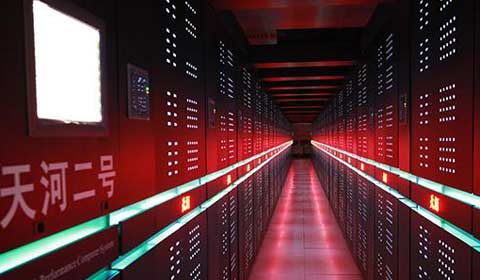 |
|
File photo of Tianhe-2 supercomputer [Photo/people.com.cn] |
Tianhe-2, developed by China's National University of Defense Technology and deployed at the National Supercomputer Center in Guangzhou, capital of south China's Guangdong Province, has held the title for China since June 2013.
 |
 |
Tianhe-2 "features a number of Chinese-developed components, including the TH Express-2 interconnect network, front-end processors, operating system and software tools," the list said.
Sequoia, installed at the DOE's Lawrence Livermore National Laboratory, is still No. 3 system with a performance of 17.17 Pflop/s. Japan's K computer is No. 4 system with 10.51 Pflop/s, followed by Mira, installed at the DOE's Argonne National Laboratory, which has a performance of 8.59 Pflop/s.
"In fact, there was little change among the ranking of the world's top 10 supercomputers in the latest edition of the closely watched list," the organizers of the Top500 list said in a statement.
"The only new entry was at number 10 -- a 3.14 Pflop/s Cray XC30 installed at an undisclosed US government site," they said.
The United States has a total of 233 systems on the latest list, down from 265 six months ago. This is near its lowest share of 226 in the early 2000s.
Chinese mainland, No. 2 consumer of supercomputers, has 76 systems, up from 63 on the previous list. That means it has almost as many supercomputers as Britain, with 30; France, with 27; and Germany, with 23; combined.
Japan also increased its showing, up to 30 from 28 on the previous list.
According to the Top500 list, the total combined performance of all 500 systems has grown to 274 Pflop/s, compared to 250 Pflop/s six months ago and 223 Pflop/s one year ago.
However, the organizers said "the overall growth rate of all the systems is at a historical low" since the list was introduced in June 1993.
"Recent installations of very large systems -- up to June 2013 -- have counteracted the reduced growth rate at the bottom of the list," the statement said.
"But with few new systems at the top of the past few lists, the overall growth rate is now slowing."
It said the market for the very largest systems "might currently behave differently" from the market of mid-sized and smaller supercomputers.
From 1994 to 2008, the annual growth rate for No. 500 systems' performance was 90 percent, but it has only grown by 55 percent per year since 2008.
The Top500 list is considered one of the most authoritative rankings of the world's supercomputers. It is compiled on the basis of the machines' performance on the Linpack benchmark by experts from the United States and Germany.
